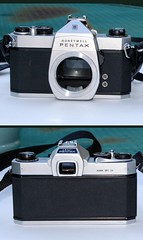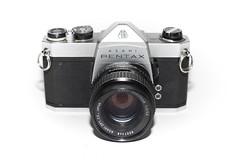Pentax Spotmatic
The Pentax Spotmatics are a range of 35mm SLR cameras made by Asahi Optical Company (later Pentax) between 1960 and 1976, designed by Dr. Minoru Suzuki. The original Spotmatic is one of the first cameras with TTL metering, if not the first; while the Electro Spotmatic (ES) and the Spotmatic F introduced aperture priority and fully opened light metering.
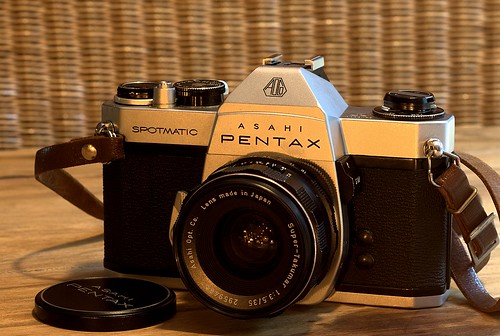
|
| Pentax Spotmatic image by stammi (Image rights) |
Contents
Description
Asahi Optical Company introduced the Spot-Matic prototype in Photokina 1960, with a light measuring system located in a small arm in the center of the viewing area, effectively metering light as a spot-meter. This design was used several years later,as technology advanced, in cameras such as the Leica CL and Leica M5. However at the time it was not practical and the Asahi staff looked for other solutions.[1]
The Spotmatic camera was launched to the public in 1964, byt that time the metering system had been changed to average-metering by using 2 small CdS cells, one on each side of the viewfinder. The change in the metering system was not reflected in the marketing materials, and the original name continued to be used.
The Spotmatic is not an evolution of the previous Asahi cameras, but a completely new design inside and out. Camera body and mirror box are made of aluminum, the mirror mechanism was improved, and more importantly the shutter was a new design. In the new design the life cycle in increased from 20,000 to 100,000 and the flash synchronization is 1/60 instead of 1/50. Focusing screens design allowed for a brighter viewfinder with easier to focus. Film transport guide rails were broadened and the pressure plate elongated to keep the film flatter. Self-timer mechanisms was redesigned as well.[2]
All Spotmatics use the M42 lens mount and in the final models fully opened light-metering is possible with mechanical changes in the SMC-Takumar lenses. In the United States, Spotmatic cameras were imported and marketed by Honeywell and bear the name "Honeywell Spotmatic" , while in the rest of the world they had the name "Asahi Spotmatic". A series of different models were made with minor changes and improvements:
The Spotmatic SP
The Spotmatic SP was introduced by Asahi Optical Company in 1964, and was one of the first 35mm SLR cameras with through-the-lens light metering. The camera was entirely mechanical apart from the light meter, which was powered by a 1.35 volt PX400 mercury cell. Mercury batteries are now banned but Zinc-Air batteries can be used instead, or it is possible to carry out a minor modification to the meter circuit to allow the use of 1.55 volt 387S silver-oxide batteries. Later versions of the camera can use silver-oxide batteries without any modification.
A small switch on the (photographer's) left side of the lens housing was pushed up to stop down the lens and activate the meter; the exposure controls would then be adjusted to center a needle on the right edge of the viewfinder. The body took lenses with an M42 screw thread, providing a large range of available lenses. The system became the workhorse of many professionals of the period. The Spotmatic SP did not have a hot-shoe but an accessory cold-shoe. Focusing screen is a fresnel type microprism with 0,85x magnification; with the 55mm f/1.8 lens the camera could be used with both eyes open for sports.
Three variants of the Spotmatic SP are common:
1) Black and chrome body with Asahi Pentax badge on prism housing, Spotmatic badge on front below shutter release and SP badge on top near the rewind knob.
2) All black body with Asahi Pentax badge on prism housing, Spotmatic badge on front below shutter release and SPbadge on top near the rewind knob.
3) Blank and chrome body with Honeywell Pentax badge on prism housing and Spotmatic badge on front below shutter release (but no correspond SPbadge).
- Type: SLR body
- Manufacturer: Asahi Optical Co.
- Year of launch: 1964
- Films: 35mm, speeds up to 1600 ASA
- Viewfinder: pentaprism eye-level viewfinder
- Lens Mount: Pentax/Praktica screwmount (M42x1)
- Shutter: Focal plane shutter, speeds 1 - 1/1000 second, flash sync 1/60 second
- Metering: CdS TTL metering (stopped-down manual match-needle metering system) EV 1.7 ~ 18 (ISO 100) ASA range 20-1600 (on original Spotmatic)

|
| Spotmatic SP image by Akira Nakajima (Image rights) |

|
| Spotmatic SP top plate image by AWCam (Image rights) |
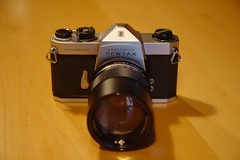
|
| Honeywell Pentax Spotmatic SP image by steevithak (Image rights) |
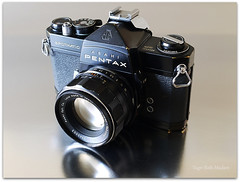
|
| Black Asahi Spotmatic SP image by Vagn Sloth-Madsen (Image rights) |
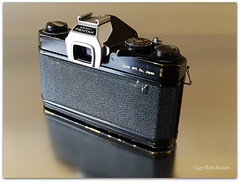
|
| Black Asahi Spotmatic SP image by Vagn Sloth-Madsen (Image rights) |
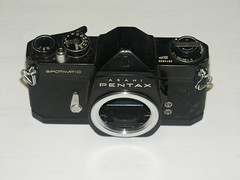
|
| Black Asahi Spotmatic SP image by Jimmy Smith (Image rights) |

|
| Spotmatic focusing screen and lightmeter image by Pablo Coronel (Image rights) |
The SL
The Pentax SL is identical to the Spotmatic SP except that it does not include built-in light metering. Like the SP, it came in 3 variants, black and chrome Asahi, black Asahi, black and chrome Honeywell.
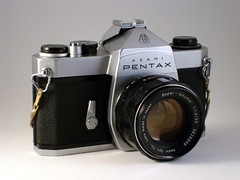
|
| Black and Chrome Asahi Pentax SL image by Guy Kokken (Image rights) |

|
| Black and Chrome Honeywell Pentax SL image by Matt Phillips (Image rights) |
The SP500 and SP1000
The SP500 and SP1000 are identical to the Spotmatic SP except there is no self timer. The SP500 shutter speed dial shows a max speed of 1/500, however, like the SP1000 and SP, the SP500 can actually shoot at 1/1000 by turning the shutter speed dial to an unmarked stop after 1/500. The SP1000 (1973 to 1976) was the replacement model for the SP500 (1971 to 1974). Like the SP, the SP500/SP1000 models came in 3 variants, black and chrome Asahi, black Asahi, black and chrome Honeywell.
|
|
|
The Spotmatic SP II
An updated version of the original Spotmatic SP, launched in 1971. As well as a number of minor improvements to the meter components and film transport, the SP II was fitted with a hot shoe with a switch under the rewind crank for FP and X-flash synchronization and the ASA range was increased to 3200.
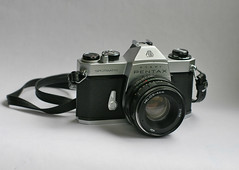
|
| Black and chrome Asahi Pentax Spotmatic SP II image by Derek von Essen (Image rights) |
The Spotmatic SP IIa
Virtually identical to the SP II, but with an "electric eye" introduced to support the Honeywell Strobonar line of dedicated flashes. It was only available in the North American market, in black and with the Honeywell badge.

|
| Honeywell Pentax Spotmatic SP IIa with a 50/4 Macro SMC Takumar image by Pablo Coronel (Image rights) |
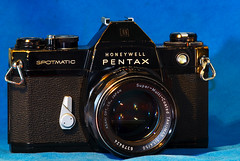
|
| Black Honeywell Pentax Spotmatic SP IIa image by Kimmo Kulovesi (Image rights) |
The Spotmatic SP F
The Spotmatic SP F, launched in 1973, included several improvements. It was the first version to offer open-aperture metering, but this needed the updated Super-Multi-Coated (S-M-C) Takumar lenses with an aperture-position linkage to the camera. The FP option for the hot shoe synchronisation was dropped and the meter circuit design was revised to take account of the lens aperture setting and to indicate correct exposure when zero current is flowing through the meter, which now allowed for a variation in voltage from the battery. The battery now needed extra capacity and was changed to the now-defunct PX625 mercury cell. The light meter is constantly switched on but there is an automatic cut-off when the light is at EV2 or less, so it is important to keep the lens cap on when the camera is not in use, in order to conserve the battery.

|
| Asahi Pentax Spotmatic F image by John Nuttall (Image rights) |
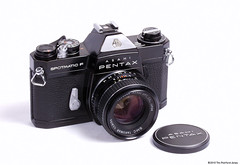
|
| Black Asahi Pentax Spotmatic F image by Tim Jones (Image rights) |
The ES
Automatic exposure (aperture priority) and manual mode camera with automatic speeds from 1-1/1000 and manual speeds from 1/60 - 1/1000 seconds. The light meter operates only when the shutter button is pressed and only in auto mode and the meter needle now indicates the auto shutter speed. Open-aperture metering with the S-M-C and SMC Takumar lenses, as for the SP F, is maintained. This camera is powered by one 4SR44 6.2v silver oxide battery and there is a battery check button.
The ES II
Similar to the ES, but with a self timer, shutter release lock, interior viewfinder blinds and shutter speeds from 8 seconds to 1/1000th second in auto mode. The power supply is now four modern 1.5v alkaline or silver oxide cells.
References
Kepler H. 1974 The Pentax Way. 8ed. Focal Press, London
Links
- Repair Notes on the Spotmatic
- Manual Camera User's Opinion about the Spotmatic
- Manual Camera User's Opinion about the Spotmatic F
- Spotmatic at Karen Nakamura's Photoethnography.com
- User's manuals at Pentax Imaging:
- Manuals of Spotmatic and Spotmatic II at Orphan Cameras (Mike Butkus' site)
- Manuals at Pentax Manuals by Kim Coxon
- Spotmatic, SP500, SP1000 on www.collection-appareils.fr by Sylvain Halgand (in French)
- Flickr set by steevithak: Photos of and with the Honeywell Pentax Spotmatic SP

